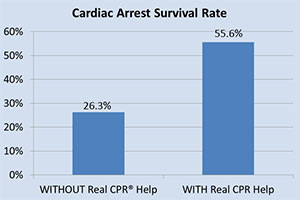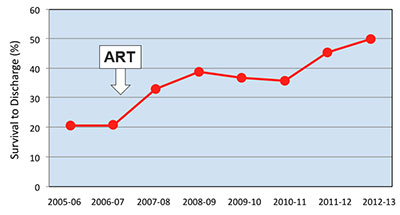Better Outcomes Realised
Data from EMS providers in Arizona and an academic medical center in California show that high-quality CPR does save lives—and that ZOLL technology helps providers deliver high-quality CPR.
Odds of Survival More than Doubled
In the pre-hospital setting, ZOLL technology and training combined to more than double the odds of survival to discharge for patients in Arizona. This dramatic improvement was achieved when emergency responders in Mesa used ZOLL defibrillators with Real CPR Help® and CPR Dashboard™ and received specialised (scenario-based) training. With these technologies, rescuers know if they are pushing hard enough and fast enough to meet current CPR Guidelines and also know how long they have been off the chest when compressions are paused.
As documented in a large study, a person who suffered cardiac arrest would be 2.72 times more likely to survive if the EMS provider used this technology and received this training than a similar patient who was treated by an EMS provider with traditional CPR training and no feedback technology.1 Among study participants whose cardiac arrest was witnessed and due to ventricular fibrillation (a shockable rhythm), survival to discharge more than doubled, from 26.3% to 55.6%, if these patients were treated by an EMS provider who used the feedback technology and received the scenario-based training (Figure 1). These results were published in the Annals of Emergency Medicine in 2013.1
Figure 1. Survival from witnessed VF cardiac arrest in Mesa, Arizona
This study showed that a person whose cardiac arrest was witnessed and due to ventricular fibrillation (VF) was twice as likely to survive, 55.6% versus 26.3%, when emergency responders used defibrillators equipped with Real CPR Help and CPR Dashboard and had received scenario-based training.
This study which involved almost 500 patients was spearheaded by Bentley Bobrow, MD, medical director for the Arizona Department of Health Services Bureau of EMS and Trauma System. In an interview with Occupational Health & Safety, Dr. Bobrow said, “There is mounting evidence that there is an enormous difference between outcomes for cardiac arrest victims when they gave good-quality CPR and bad-quality CPR. It’s also really challenging to do high-quality CPR, we think especially without the assistance of some technology that can help people do high-quality CPR.”
The ART of Resuscitation
The University of California, San Diego (UCSD) Medical Center is using ZOLL technology as part of its innovative and very successful Advanced Resuscitation Training (ART) program. The brainchild of Daniel Davis, MD, director of UCSD’s Center for Resuscitation Science, a core principle of ART is preventing interruptions in compressions at all costs. The UCSD hospitals use ZOLL ALS (advanced life support) defibrillators with Real CPR Help, CPR Dashboard, and ZOLL’s industry-exclusive See-Thru CPR® technology, which reduces the duration of pauses in CPR by enabling providers to see the patient’s underlying cardiac rhythm during CPR. In addition, for post-code debriefing and training, the hospital uses RescueNet® Code Review.
Since its implementation at UCSD hospitals in 2007, the incidence of cardiac arrest is down, and the survival-to-discharge rate among patients who do suffer cardiac arrest now approaches 50% (Figure 2). Survival from cardiac arrest has doubled since ART was instituted, from 21% to 42%, on the wards.2 In the intensive care unit, survival to discharge increased from 23% to 32%. And neurologically intact survival among all patients doubled, from 10.4% to 21.2%. Based on these impressive results, ART training has been selected as a Joint Commission Best Practice.
ZOLL is taking the guesswork out of CPR, and patients are benefitting.
Figure 2. Survival to discharge after cardiac arrest at UCSD
Since the implementation of the ART program in 2007, survival to discharge after cardiac arrest now approaches 50%.
1Bobrow BJ, et al. Ann Emerg Med. 2013 Jul;62(1):47–56.e1. Epub 2013 Mar 7.
2Davis, DP. A New Algorithm for CPR Training. Medcom Trainex CEU program. 2012.


